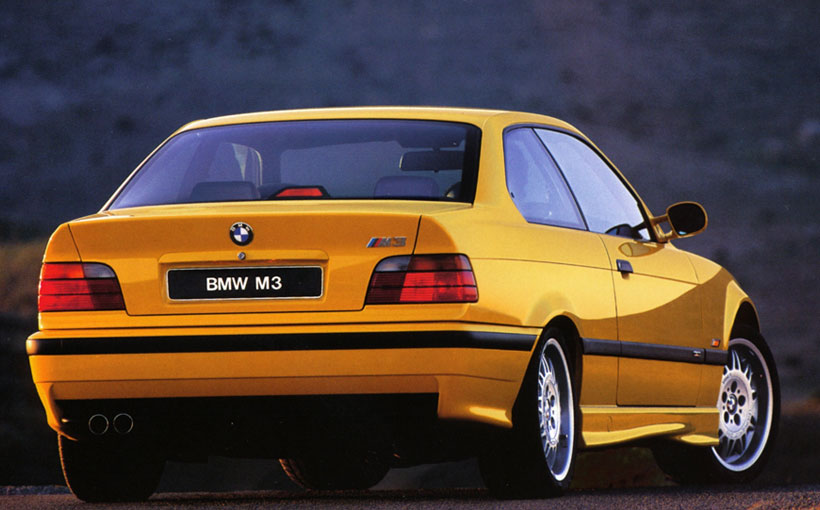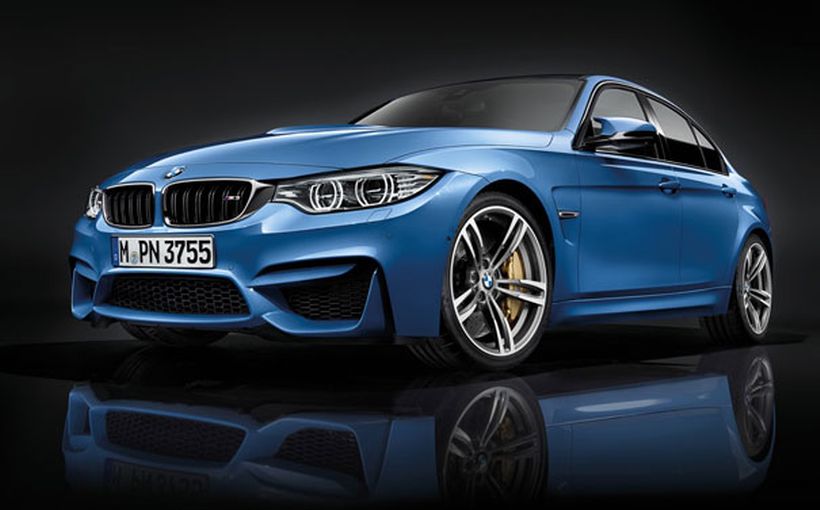BMW M3: One letter plus one number spells a new motoring niche

To understand why BMW created the M3, it is important to know something about the 2002, the model that created the template for the Ultimate Driving Machine. The late David E. Davis, famous for his colourful contributions to Car and Driver and later for founding Automobile magazine, wrote in January 1968: ‘…to hell with all of them. Let them stay in the automotive dark. I know about the BMW 2002.’

When the original E21 3-Series was introduced in 1975 to replace the 02-Series, many BMW enthusiasts feared there would never be a successor to the 2002. Certainly the standard 318 and 320i lacked the edge of the old model, were softer and targeted at a less specialist audience.
It was not until well into the life of the second generation E30 3-Series that BMW once again introduced a dedicated sporting car to satisfy the keenest enthusiast. The new M3 was also intended to continue BMW’s widespread success in motorsport and the ‘M’ stood simply for Motorsport, the company’s dedicated racing division. BMW Motorsport GmbH was established in 1972 and six years later produced its first fruit in the glorious guise of the M1, intended first for the track and later for the road. ‘M’ is probably the single most recognised capital letter in the history of the automotive industry.

But why did it take BMW management more than a decade to replace the 2002 Tii? The answer to this question goes a long way to defining a dilemma that faces the manufacturer of highly specialist cars that wishes to survive as a proudly independent company. The 1962 BMW 1500 brought a bigger market share for the Bavarian manufacturer, but even so production volumes did not compete with those of Daimler-Benz, let alone companies such as Fiat and Peugeot, who also produced sedans with a sporting flavour. The E21 3-Series was conceived as the car to put BMW among the world’s mass automotive manufacturers and entirely succeeded. The price to be paid was by the hardline enthusiasts as BMW became a household name.
So inferior was the E21 to its illustrious forebear, the 2002, that it was perhaps just as well that no M3 variant was attempted. In the Australian context of 1976 when these cars were introduced, any BMW was deemed exciting, but it’s worth noting that the 1977 Holden HZ Kingswood/Premier with the much vaunted ‘Radial Tuned Suspension’ handled better than either the 3-Series BMW or the 5-Series, launched a couple of years earlier. Modern MOTOR magazine featured a brilliant cover line, in which it compared the Kingy with a 528i: ‘A Good Car Spoiled by the Handling, A Good Handler Spoiled by the Car’!

The second generation E30 3-Series arrived in Australia to great excitement in 1982. At the time I was a journalist working for (what had by then become) MOTOR magazine. The 323i five-speed manual sedan – even though the E30 was sold here initially as a two-door only, like the old 2002, you wouldn’t call it a coupé – was a thing of absolute joy with its sublime six-cylinder engine, crisp but unmistakably BMW demeanour and beautifully configured interior. The M3 variant was still four years into the future and, paradoxically, it would not use the lovely BMW 2.3-litre sixpack but a seriously tweaked four-cylinder unit of the same capacity. This engine derived from the M10 unit designed by Baron Alex von Falkenhausen and fitted to the ‘Neue Klasse’ 1500 sedan of 1962. The turbocharged M12 engine that powered BMW’s Formula One machines of the early 1980s was also developed from the M10. So, some pedigree.
The E30 M3 made its debut at the 1985 Frankfurt motor show and production began in June 1986. Although it was never sold in Australia, the M3 soon earned local fame for its motor racing successes. It could be seen as David to the Nissan GT-R’s Goliath, in the way the Torana XU- played that role versus the Falcon GTHO.
Unlike its 2002 predecessor, the M3 was developed with racing at the top of its agenda, specifically the World Touring Car Championship for Group A cars. To be eligible – or, to use that awkward motor racing specific verb ‘homologated’ – a minimum number of roadgoing versions had to be manufactured. Because of its purpose-built nature, the E30 was never made as a right-hand drive car.

The original M3 gave 195 brake horsepower at 6,750 rpm with 226 Nm of torque at 4,600. It had a close-ratio five-speed manual transmission. Power to weight and exceptional agility were the M3’s hallmarks, the car weighing just 1,200 kg. Zero to 100 km/h took seven seconds flat and the top speed was 235 km/h.
In March 1988 the first Evolution variant appeared. Peak power was up to 215 bhp at 7,650 rpm with 230 Nm at 4600. Wheels were up from 15 to 16 inches, although still seven inches in width. Remembering that this was still half a decade before the arrival of Subaru’s formidable rally-focused Impreza WRX, the zero to 100 time of 6.7 was brilliant and V-Max was now 241.
In January 1990 the Sport Evolution appeared. It had more capacity at 2,467 cc and developed 238 bhp at 7,000 rpm and 240 Nm at 4,750. It still weighed just 1,200 kg and could despatch the 100 km/h sprint in 6.5 seconds on the way to a top speed of 248, just 2 km/h shy of the number at which BMW, Mercedes-Benz and Audi speed-limited their cars. Various other limited edition variants were offered in Europe over the model’s lifespan.
Sadly, the aforementioned World Touring Car Championship was run only in 1986. In a sense, this left BMW with an icon without a showcase. It meant that the second generation E36 M3 could be developed as a car with broader market appeal.

The E36 was surprisingly different. Introduced in Europe in 1992 and in Australia two years later, this one used an awesome straight six. Like every other BMW sixpack of the time, it was electronically injected, had dual overhead camshafts and four valves per cylinder. But the M3’s 3.0-litre engine had a new variable camshaft timing system (‘VANOS’). Previous BMW six-cylinder engines had glorious top-end power but were somewhat lacking in lowdown torque. But the M3 gave even more of the first without a hint of the latter.

At this point in the story, my personal experiences of BMW ownership seems relevant. I have owned five of them, including an E36 M3. First, in 1983, came a 1973 E3 3.0S automatic. This was one of the best cars I have ever owned relative to its time, but it was desperately shortchanged by the three-speed auto, which made this ultimately fast sedan slow off the mark. I later had two different E12s. The first was a 1983 528i with three-speed auto and the second a 1984 model much improved with an extra ratio in its transmission, although still not that smart from a standing start. I owned these in 1995-96. Then, in time for the second running of Targa Tasmania in 1993, came a 635 CSi with close-ratio Getrag five-speed. This car never felt underdone on torque, but by comparison the E36 is dramatically quicker, while being much happier to pull fifth gear at quite low road speeds. So it’s not exaggerating to say that the E36 M3 gave BMW’s famous six-cylinder engines a huge point of distinction. The E36’s engine was surely the world’s finest sixpack in 1992. By the way, my car is a manual and my advice is to avoid the SMG variant, which, for me, robbed the car of much of its Ultimate Driving Machine credentials.
There is one negative to the E36. In motorsport circles, weight is always regarded as the enemy of performance. This car defied its compact dimensions of 4,435 mm length, 1,710 mm width and 1,335 mm height by weighing a hefty 1,460 kg. The E30 was just 85 mm shorter, while standing 55 mm wider and 15 mm higher. But it weighed 260 kg less.
Looking back, it now seems that the 1990s was a decade where safety was seen as increasingly important but weight-saving took a lower priority. The E36 did have an aluminium bonnet but surely more kilograms could have been saved somewhere?

So it is that the overall performance of the E36 is not all that much superior to its four-cylinder forbears. Maximum power is up to 286 bhp (210 kW) with 320 Nm of torque at just 3600 rpm, but the zero to 100 km/h time of six seconds is only half a second swifter than that of the Sport Evolution. The top speed would be well north of 250 km/h though, were it not for the rev-limiter.
An Evolution variant of the E36 arrived locally in 1996 with a six-speed gearbox and an increase in capacity from 2,990 cc to 3,201. Power jumped to 236 kW and torque to 350 at 3,250. It could sprint to 100 km/h in a getting-serious 5.5 seconds.

Although the fourth generation E46 3-Series was arguably less of a step forward than either of its two predecessors had been, the flagship M3 variant shrugged off any of its lesser siblings’ blandness. It was released two years after the sedans in March 2000. Like the E36, the E46 coupé body (and by this time it was no longer looking like a two-door sedan) differed significantly from the sedan, being both longer and wider. The heftier E46 M3 came in at 1,495 kg. But there was also more of most things, including wheel width. The E36 had 7.5s, but the new coupé got eights up front and nines to handle the power. The stance was even more obviously muscular. Power was now 252 kW at 7,900 rpm with 365 Nm of torque at a higher 4,900 rpm. Zero to 100 took 5.2 seconds. By the standards of its time, the E46 M3 was perhaps less impressive than any of its predecessors; by 2000 the WRX STi was its equal on acceleration.

The engineers at M doubtless saw the new model’s shortcomings or, rather, its middle-aged spread. Focused on a Nürburgring lap time of less than eight minutes, they created the CSL. Seven kilograms were saved by fitting a carbonfibre roof. Some 50 kg was pulled from the interior, thanks to lightweight seats, centre console, glass and door panels. The 19-inch BBS wheels were lighter, too. Aluminium lower control arms and a carbonfibre front bumper were also included. As for the plastic composite bootlid, its main aim was to improve aerodynamics. The ride height was dropped 10 mm and the suspension upgraded. The quicker steering rack was also welcome.

A beautifully fabricated carbon airbox made the major contribution to creating the CSL’s spine-chilling exhaust note. For some, the disappointment was that you couldn’t specify an old-fashioned manual gearbox but the SMGII transmission did make for quicker times. Only 27 E46 M3 CSLs were delivered new in Australia. A less expensive alternative was the CS, which lacked the carbonfibre roof and hardcore sports front seats.
All M3s have a following but it does seem that the E36 is the least fondly regarded. That said, it also has significant potential for appreciation, as does the E46, while the E30 has long been a favourite with collectors. In summary, these are all wonderful cars. Because of its fantastic motorsport history, the E30 will always be the most revered, but the six-cylinder E36 and E46 offer quasi-supercar performance on a modest budget, while delivering brilliant dynamics and a lovely driver-focused cabin.






